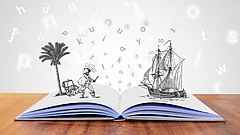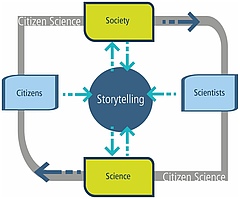Storytelling in the practise of Citizen Science

Storytelling is a communication tool to trigger interest, bring joy and allow the understanding of complex systems. (Image: Pixabay)

Generalized model of storytelling in citizen science based on the functions of storytelling in citizen science providing a visual representation of the various interactions in play. The outer arrows indicate how citizen science, understood as engagement in scientific processes, connects society with science and through its actors (citizens, scientists). Storytelling creates shortcuts among these actors. (Image: Anett Richter)
Report by iDiv alumna Anett Richter, now scientist at Thünen Insitute, on a new publication in Journal of Science Communication:
Leipzig. Storytelling is understood by many as a communication tool to trigger interest, bring joy and allow the understanding of a complex system. Storytelling is also a method in science communication and, thus, the centre of investigation for researchers from multiple disciplines. In citizen science, where members of the public cooperate with scientists to generate new knowledge, pursue educational goals or gain empowerment as citizens, storytelling is expected to be an integrative part of the communication strategy to find a common language. But can storytelling act as more than a tool for communication? And if so: What are these functions and pathways of storytelling in citizen science?
When investigating storytelling, the first selection to be made is the language of the stories being investigated. The second selection is the choice of format in which the stories are being communicated. In the German-speaking countries Austria, Switzerland and Germany, citizen science platforms are well established and represent todays citizen science practise. We decided to investigate all citizen science projects that are represented on these platforms and analysed the role of storytelling in these projects. Once we had established an overview of the projects that apply storytelling, we developed categories and investigated the functions. In a process of abstraction of these functionalities, we derived to a generalised model and some more insights into the significance of storytelling in citizen science.
We found that storytelling has manifold functions. By analysing over 209 analysed projects from Austria, Switzerland and Germany and with the help of two expert workshops to validate the findings, we distinguished the application and integration of storytelling along three major categories. Stories are part of citizen science and function as 1) core research objectives, 2) agents and/or 3) tools.
These functions build linkages between citizens and science and each story facilitates interactions between people and science. The narratives in storytelling act as connecting elements, as co-operator to achieve the goals of the citizen science project. We show that stories create “shortcuts” between science and society and stories stand for the connection of individuals or communities.
In conclusion, we suggest that storytelling should be a prerequisite to enhance the competencies of the actors involved and to exchange knowledge at the interfaces of science and policy as well as science and society.
Anett Richter
Original publication:
(iDiv scientists bold)
Richter, A., Sieber, A., Siebert, J., Miczajka-Rußmann, V., Zabel, J., Ziegler, D., Hecker, S. and Frigerio, D., 2019. Storytelling for narrative approaches in citizen science: towards a generalized model. Journal of Science Communication, 18(6), p.A02. DOI: 10.22323/2.18060202
Contact:
Dr Anett Richter
Thünen-Institut für Biodiversität
Bundesallee 65
38116 Braunschweig
Tel. 0531 596 2686
E-mail: anett.richter@thuenen.de
Kati Kietzmann
Media and Communications
German Centre for Integrative Biodiversity Research (iDiv) Halle-Jena-Leipzig
Phone: +49 341 9733106
E-mail: kati.kietzmann@idiv.de
